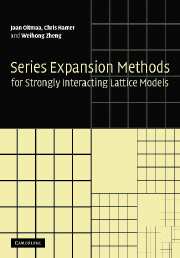Book contents
- Frontmatter
- Contents
- Preface
- 1 Introduction
- 2 High- and low-temperature expansions for the Ising model
- 3 Models with continuous symmetry and the free graph expansion
- 4 Quantum spin models at T = 0
- 5 Quantum antiferromagnets at T = 0
- 6 Correlators, dynamical structure factors and multi-particle excitations
- 7 Quantum spin models at finite temperature
- 8 Electronic models
- 9 Review of lattice gauge theory
- 10 Series expansions for lattice gauge models
- 11 Additional topics
- Appendix 1 Some graph theory ideas
- Appendix 2 The ‘pegs in holes’ algorithm
- Appendix 3 Free graph expansion technicalities
- Appendix 4 Matrix perturbation theory
- Appendix 5 Matrix block diagonalization
- Appendix 6 The moment–cumulant expansion
- Appendix 7 Integral equation approach to the two-particle Schrödinger equation
- Appendix 8 Correspondences between field theory and statistical mechanics
- Appendix 9 Computer programs
- Bibliography
- Index
Appendix 1 - Some graph theory ideas
Published online by Cambridge University Press: 06 January 2010
- Frontmatter
- Contents
- Preface
- 1 Introduction
- 2 High- and low-temperature expansions for the Ising model
- 3 Models with continuous symmetry and the free graph expansion
- 4 Quantum spin models at T = 0
- 5 Quantum antiferromagnets at T = 0
- 6 Correlators, dynamical structure factors and multi-particle excitations
- 7 Quantum spin models at finite temperature
- 8 Electronic models
- 9 Review of lattice gauge theory
- 10 Series expansions for lattice gauge models
- 11 Additional topics
- Appendix 1 Some graph theory ideas
- Appendix 2 The ‘pegs in holes’ algorithm
- Appendix 3 Free graph expansion technicalities
- Appendix 4 Matrix perturbation theory
- Appendix 5 Matrix block diagonalization
- Appendix 6 The moment–cumulant expansion
- Appendix 7 Integral equation approach to the two-particle Schrödinger equation
- Appendix 8 Correspondences between field theory and statistical mechanics
- Appendix 9 Computer programs
- Bibliography
- Index
Summary
This appendix provides a brief introduction to topics in the mathematical field of Graph Theory, which are pertinent to the subject of series expansions. For further details the reader is referred to Domb (1974) and to Chartrand (1977).
We start with some definitions.
(i) A graph is a collection of points (vertices) and lines (bonds) (see Figure A1.1).
(ii) A connected graph is one in which there is a path between any pair of points. A disconnected graph is one which is not connected. The number of components of a disconnected graph can be 2, 3, …
(iii) An articulation point (articulation vertex) is a vertex, the removal of which, with all of its incident lines, breaks the connectivity of the graph.
(iV) The order (degree) of a vertex is the number of lines incident on the vertex. Note that if a vertex is of order 1, then the vertex to which it is joined is an articulation vertex.
(v) A star graph is a connected graph with no articulation points.
(vi) A tree graph is a connected graph with at least one vertex of order 1 (Note that this differs from more usual definitions, but is most convenient for our purposes).
(vii) Asimple graph is one in which there is at most one line joining any pair of vertices. A multi-graph is one in which there is more than one line between at least one pair of vertices.
[…]
- Type
- Chapter
- Information
- Series Expansion Methods for Strongly Interacting Lattice Models , pp. 283 - 285Publisher: Cambridge University PressPrint publication year: 2006



